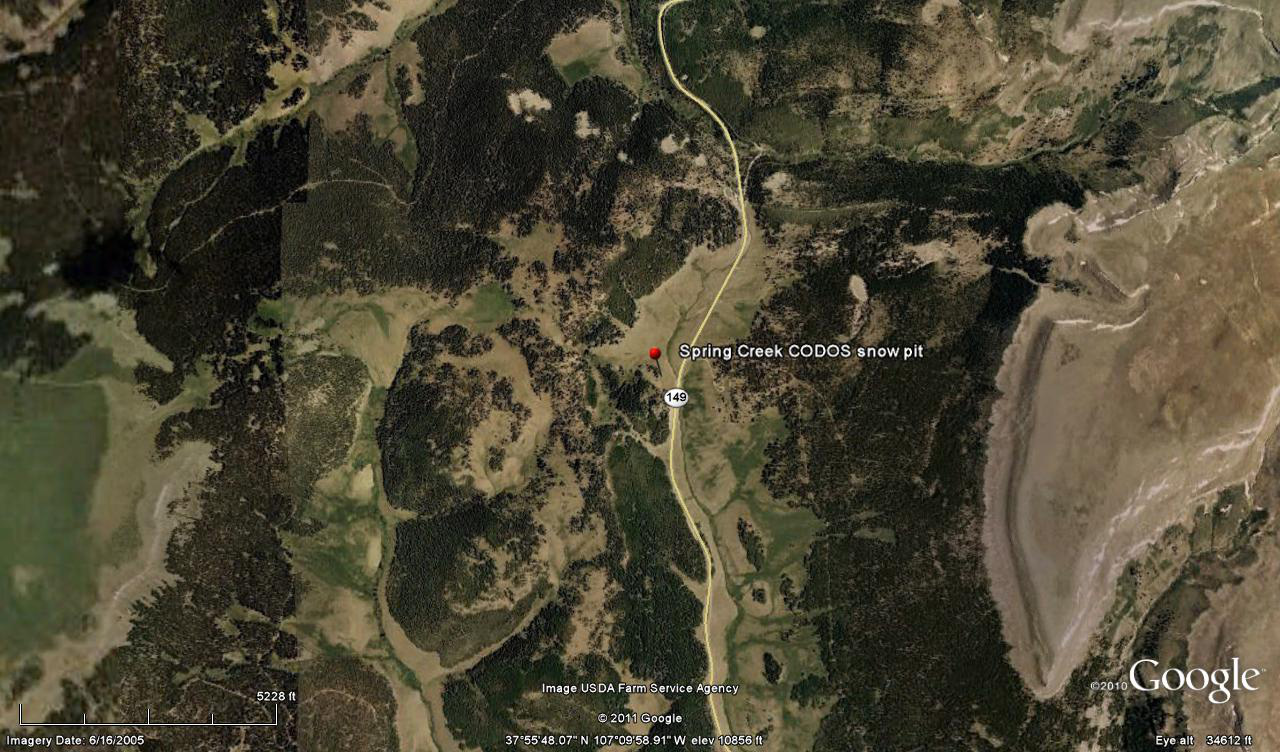 Water Year 2012 CODOS Summary
Water Year 2012 CODOS Summary
for Spring Creek Pass
Summary | Snowpack & Dust | Melt Rates | Stream Flows
Summary
Water Years 2011 and 2012 are a case study in interannual variability of Colorado snowpack formation and ablation driven by vastly different late winter and spring weather conditions, perhaps representing seasonal extremes. In dramatic contrast with the endless storms and tremendous snowpacks of Mar/Apr/May 2011, extremely dry late-winter and spring weather in 2012 resulted in very low values of peak SWE, very early in the spring, in the headwaters of the Rio Grande River.
On the other hand, the past two seasons produced comparatively smaller differences in dust-on-snow conditions, with WY 2012 coming close to matching WY 2011 at the Senator Beck Basin Study Area, our baseline monitoring site. Spring 2012 snowpack ablation at the CODOS Spring Creek Pass snowpit site was extremely rapid. In mid-March, dust-on-snow layer D4 was initiating snowpack warming at both the Spring Creek Pass and Wolf Creek Pass CODOS snowpit sites. Three weeks later, on April 9th the Spring Creek Pass site was effectively “snow all gone” (SAG), the Wolf Creek Summit CODOS site had lost nearly half of its SWE, and Rio Grande snowmelt runoff was accelerating well in advance of long-term average timing. Despite a sequence of high amplitude surges, peak flows fell short of average before a steep decline began in late May, reaching very low, late summer flows by the end of June. Overall, the Rio Grande WY 2012 snowmelt runoff hydrograph at Del Norte was advanced several weeks ahead of the period of record median timing, with an unusually steep descending limb.
SnowPack & DusT
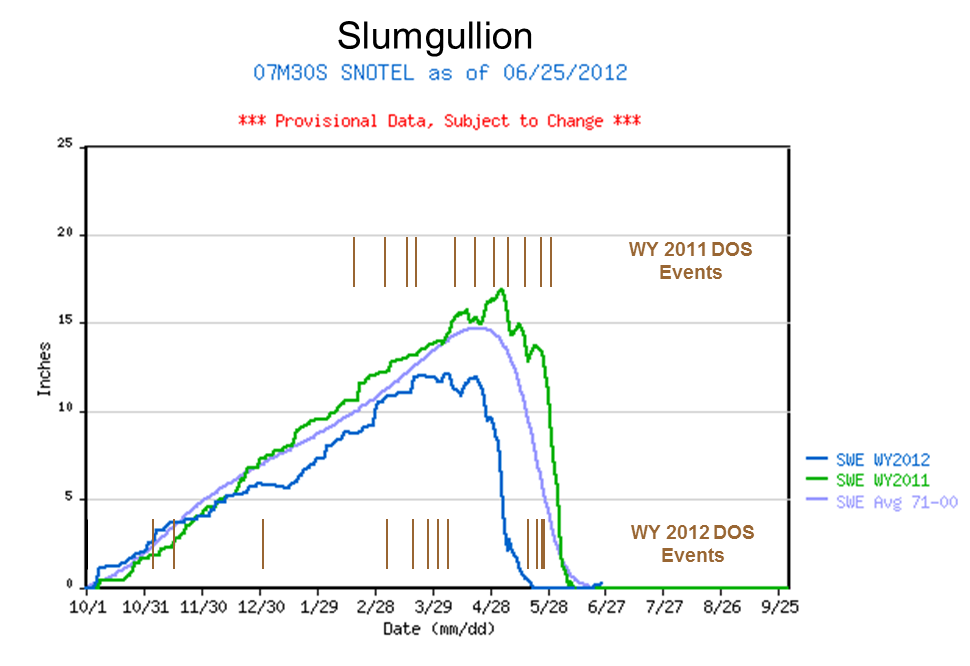
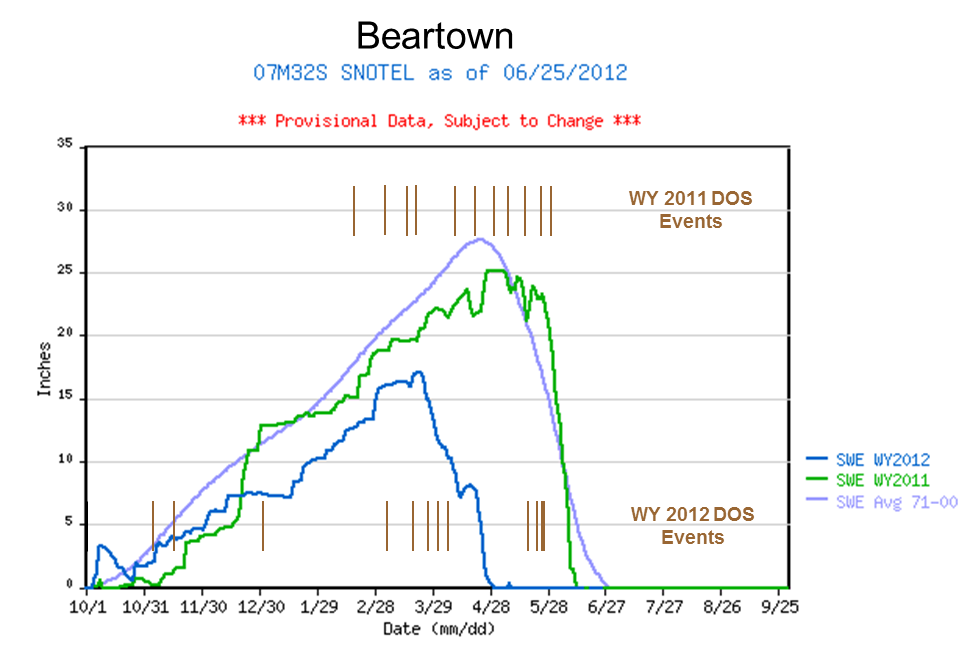
SWE accumulation and ablation for Water Years 2011 and 2012, with dust-on-snow events shown, by date, as brown bars for both water years (as observed at the Senator Beck Basin Study Area).
Water Year 2012 snowpack formation at several Rio Grande watershed Snotel sites began well, with near-average snow accumulations at Slumgullion and Wolf Creek Pass on the north and south. Beartown began falling behind average SWE first before SWE accumulation stalled at all sites in mid-late December. Subsequently, Slumgullion Pass came closest to recovering and fell just short of average SWE before peaking in mid-March. Beartown and Wolf Creek Summit peaked very near the lower quartile of values for March. Due to the very dry late-winter and spring experienced throughout Colorado, WY 2012 peak SWE at Slumgullion Pass was only 12.1”, short of the 1971-2000 average of 14.7” and far short of the 16.9” peak of 2011. Peak SWE 2012 also occurred early in the season, on April 6th, seventeen days earlier than the 1971-2000 average of April 22nd and almost a month earlier than Peak SWE 2011, on May 4th.
Near the headwaters, the Beartown Snotel recorded a larger but earlier WY 2012 peak SWE of 17.1” on March 23rd. To the south, the Wolf Creek Summit Snotel peaked at 29.7” on March 25th. Although WY 2012 peak SWE at Slumgullion Pass fell near the median SWE for that day in the period of record, the subsequent dry weather resulted in SWE falling into the lower quartile of values for the remainder of the season (see Snotel projection plot below). Peak SWE at Beartown (projection plot) occurred very near the lower quartile of values there, and thereafter the snowpack fell further into that lower quartile, ending with SAG earlier than any prior date in the period of record. Wolf Creek Summit (projection plot) experienced a similar pattern but SAG was within the period of record there. Of all three of these Snotel sites, Slumgullion Pass exhibited less overall variation between WY 2011 and 2012 than Beartown and Wolf Creek Summit, but the WY 2012 snowpack at Slumgullion was still well below par.
During WY 2011 eleven dust events occurred at Senator Beck Basin containing a total of 14 grams of dust per square meter. Most or all of those events were found in CODOS snow profiles in the Rio Grande watershed. However, relentless accumulation of late winter and spring snow routinely buried new dust layers and restored high snow albedo values throughout the State, throughout April and May.
During WY 2012 a similar twelve dust events occurred at Senator Beck Basin containing a total of ~10-12 grams of dust per square meter (see Senator Beck Basin Summary – Dust Log discussion). But, in a dramatic switch, late winter and spring 2012 were exceptionally dry, with widely spaced and comparatively small winter storms (see Senator Beck Basin – Winter Storm Log Discussion). WY 2012 dust layers and reductions in snow albedo in the Rio Grande watershed were similar to those observed in the Senator Beck Basin Study Area.
In our March 17th snow profile at Spring Creek Pass, we found event D4 dust at the snowpack surface, reducing snow albedo and generating surface melt. Nonetheless, this extremely weak snowpack, which repeatedly collapsed during our approach, retained some cold content, with a mean snowpack temperature of -1.6° C. By our return on April 9th, the Spring Creek Pass CODOS site retained only disconnected patches of thin snow, on the verge of SAG. Almost 7” of SWE had been melted in the three weeks between site visits, with dust layer D4 at the surface for most of that period.
CSAS field assistant Andrew Temple returning to the car after completing our March 17th snowpit at the Spring Creek Pass CODOS site. The shallow snowpit can be seen in the distance near the left edge of the photo, below the forest edge.

Spring Creek Pass CODOS snowpit site on the distant slope on April 9th, 2012. At lower elevations, much of the March snowpack had also disappeared.
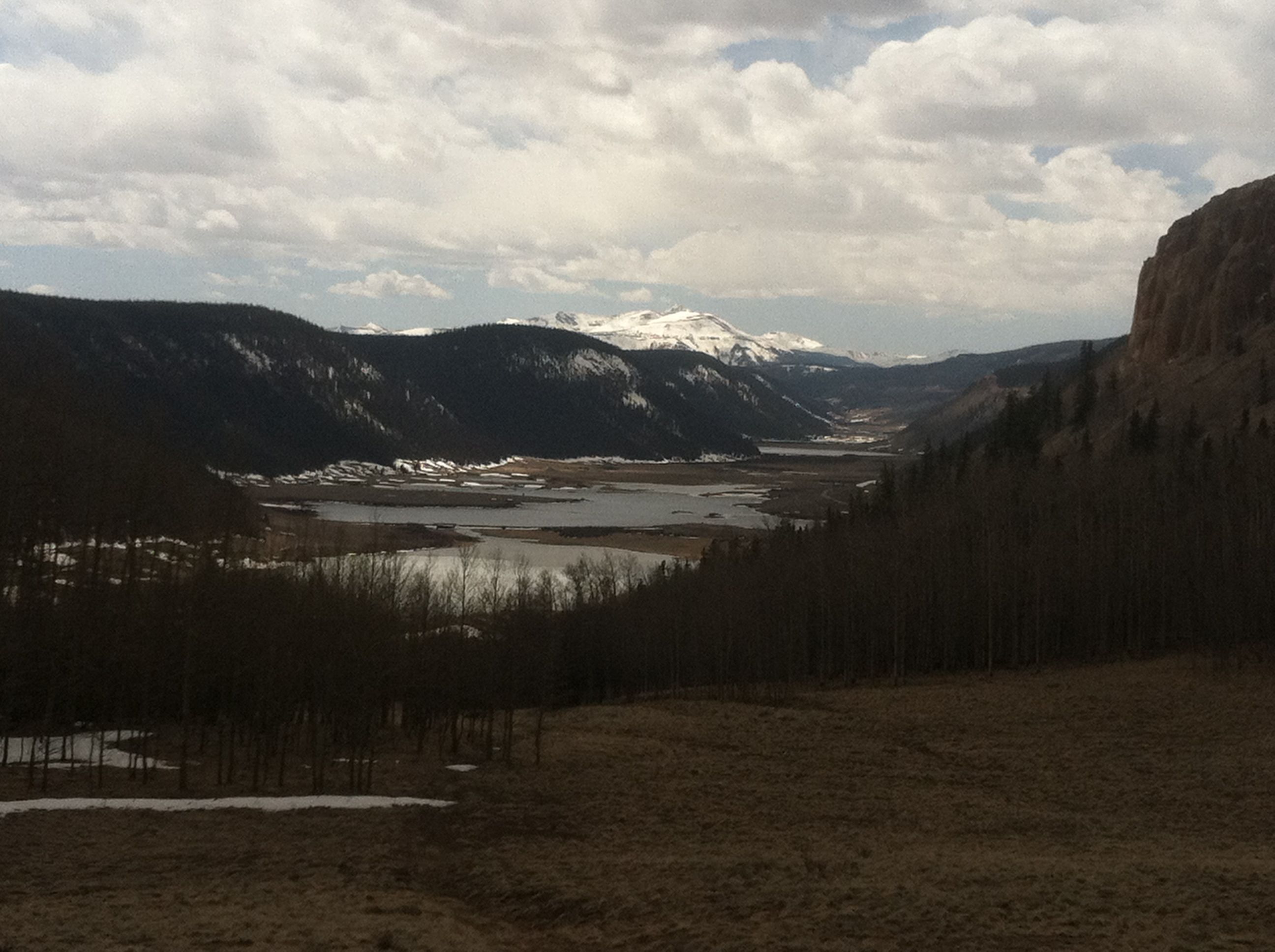
Views of the Brown Lakes on March 17th (left) and April 9th (right) in spring 2012 showing the considerable loss of snowpack.
Melt Rate
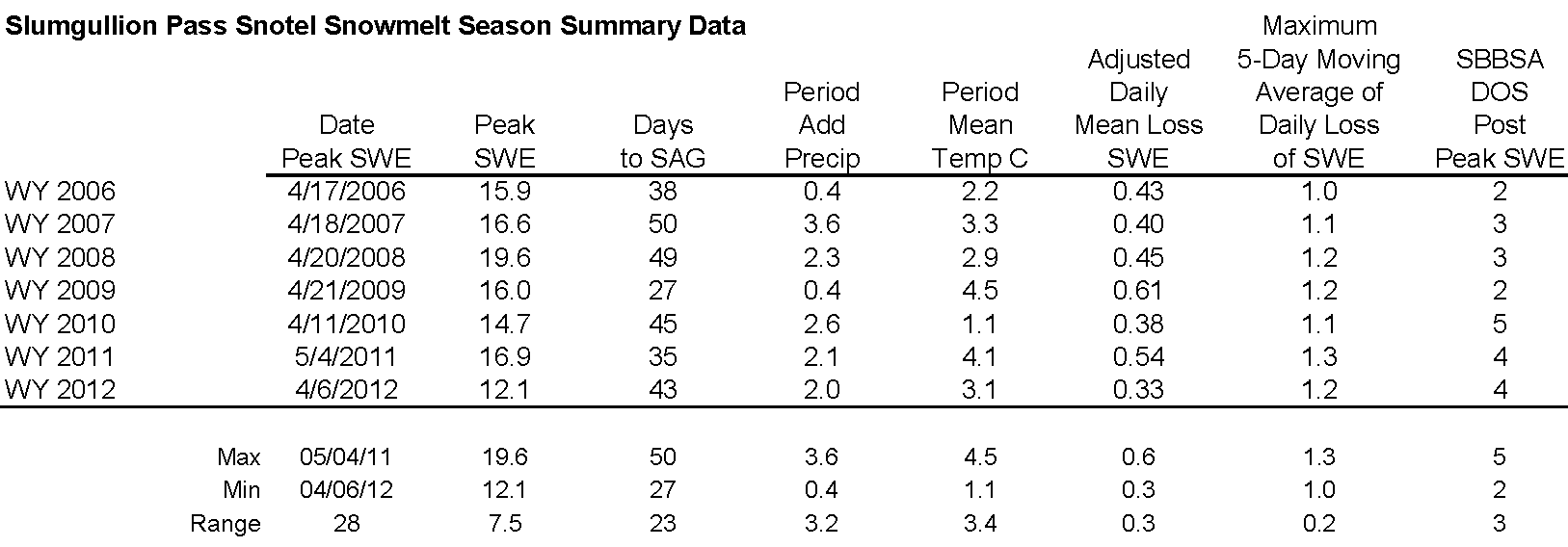
Analysis of Slumgullion Pass Snotel data for 2006-2012 snowmelt seasons showing date and quantity of peak SWE, days from peak SWE to “snow all gone” (SAG), total additional precipitation after date of peak SWE, an “adjusted” mean daily rate of snowmelt adding the additional precipitation to the peak SWE total, the maximum five-day moving average of daily melt, and the mean air temperature over the entire snowmelt period, from peak SWE to SAG.
This discussion references CODOS Snotel site data and analyzes rates of snowmelt from Spring 2006 to the present, spanning the period during which we’ve rigorously observed dust-on-snow at our Senator Beck Basin Study Area, at Red Mountain Pass. As discussed in prior CODOS Updates, many Snotel sites, including Slumgullion Pass, exhibit a radiative regime where surrounding trees reduce the access of incoming solar radiation to snowpack over the SWE measuring snow pillow, and where re-radiation of long wave energy from that vegetation and reduced skyview may inhibit radiant cooling and extend surface snowmelt during nighttime hours. As a consequence, Snotel sites often do not experience the maximum effects of dust-on-snow on snowmelt timing and rates, as compared to generally level, open meadow sites where solar access is unimpeded and snowmelt energy budgets and snowpack ablation are measured. Nonetheless, the Snotel network is the only spatially extensive system monitoring snowmelt throughout the Colorado mountains and year-to-year comparisons of Snotel melt rate data may yield insights into dust effects on local watershed-scale processes.
During WY 2012, three fall and early winter dust storms were observed low in the snowpack at Senator Beck Basin, but none of these layers was discernible in the Spring Creek Pass snowpack. And, although several dust-on-snow events fell after the date of SAG at Spring Creek Pass in WY 2012, those later events did nonetheless further reduce snow albedo and enhance snowmelt rates in the remaining snowpack at higher elevations and on shady subalpine aspects in the nearby terrain in the Rio Grande River basin.
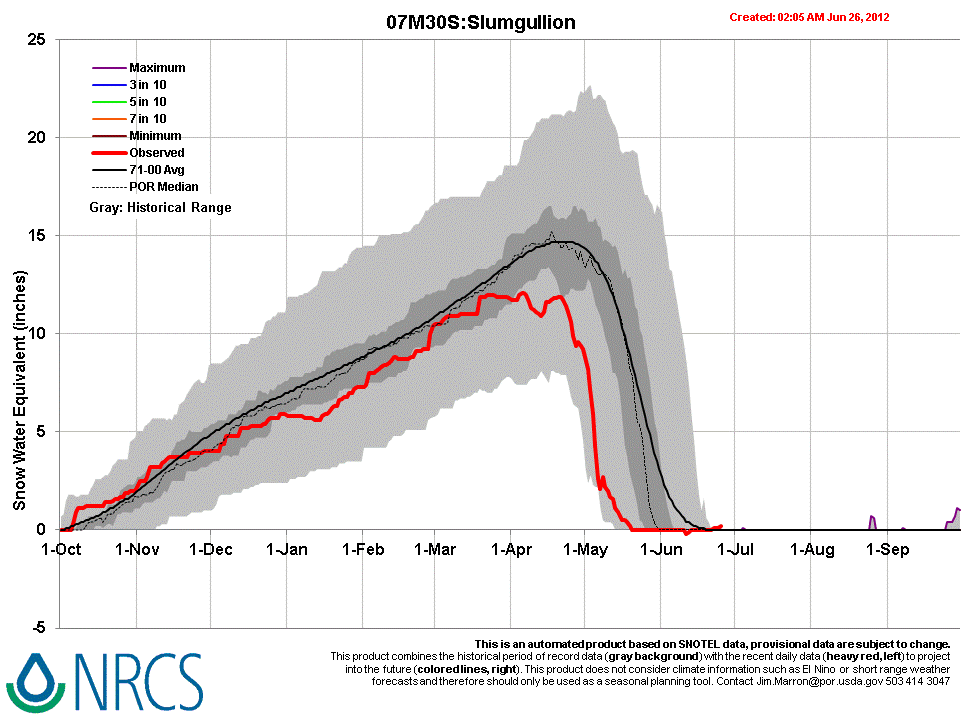
WY 2012 SWE accumulation and ablation at Slumgullion Pass Snotel, with upper and lower quartiles of period of record shown in light grey, middle quartiles in dark grey surrounding median trace for period of record, and mean trace for 1971-2000 period.
The upper Rio Grande headwaters as seen from Stony Pass on May 19th, 2012. This rare mid-May opening of the Stony Pass road opening was possible because of the season’s sub-par snowpack and early snowmelt cycle. Dust-on-snow conditions at Stony Pass closely resembled those observed at Senator Beck Basin at the time.
Because of the comparatively early date of WY 2012 peak SWE at Slumgullion Pass Snotel, on April 6th, spring 2012 produced a two-step descending limb in the SWE plot rather than the single, very steep plunge following the second peak SWE in 2011. In 2012, snowpack ablation made a false start in March before a rebound in SWE from new snow in mid-month (Storm #20 – see Senator Beck Basin Storm Log discussion). Melt resumed following peak SWE (D8 also fell on April 6th) before another interruption by additional snowfall midmonth. Snowmelt accelerated sharply as dust event D8 re-emerged and merged with underlying dust for the remainder of the melt cycle.
As seen in the Slumgullion Pass Snotel melt rate table above, Spring 2012 produced the lowest value and earliest date of Peak SWE in the past seven years yet still required more days to fully ablate the snowpack (43) than were required to melt the much larger snowpack the year before, in 2011. Since 2006, WY 2012 experienced the lowest rate of daily SWE loss (0.33” per day) for the full snowmelt period whereas 2011 melt rates were among the highest at Slumgullion Pass. The entire WY 2012 snowmelt cycle remained just within the historic range of snowmelt timing in the Slumgullion Pass period of record.
Some 42 miles to the southeast on the southern edge of the Rio Grande basin, the Wolf Creek Summit Snotel (also heavily shaded by adjoining forest) also experienced snowmelt within the lower quartile of the period of record. And, about 24 miles to the southwest of Slumgullion Pass, at the Rio Grande headwaters, Beartown Snotel immediately attained and sustained, apart from a mid-April storm rebound, a comparatively high snowmelt rate following peak SWE in late March, averaging 0.5” of SWE loss per day over the 38 days to SAG. The Beartown Snotel is just some 18 miles southeast of the Senator Beck Basin Study Area and the scant snowpack in the upper Rio Grande headwaters closely resembled Senator Beck Basin in spring 2012.
Stream Flows
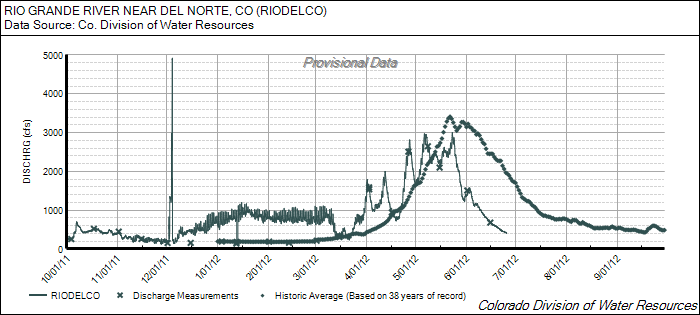
WY 2012 Rio Grande River near Del Norte Stream Gauge data for a 1,320 sq. mi. drainage area in the upper Rio Grande River watershed, above 7,980’.
Streamflow data from the Rio Grande River at Del Norte gauge presents an early and erratic ascending limb followed by a very rapid descending limb of snowmelt runoff in WY 2012. Unseasonably warm and dry weather combined with gradually increasing reductions in snow albedo by dust in March and April produced streamflows surging to several times average discharge levels in late March, April and early May, and retreating to average flow levels between surges. Discharge intersected with median levels in mid May, between nearly identical below-average peaks in flow bracketing a normal date of peak flow. The decline in flows between the two peaks may be explained by an upslope precipitation event originating in eastern Colorado delivering over an inch of precipitation as far west as Wolf Creek Summit, restoring a higher snow albedo to at least the eastern portion of the remaining snowpack in the watershed. Following the second peak in discharge, as the scant snowpack remaining at only higher elevations was rapidly consumed, steep declines in discharge resulted in flows on July 1st not normally seen until September.
Given the below-average snowpack, a reduction in snowmelt runoff yield is unsurprising. However, the Rio Grande hydrograph also presents a substantial advance in the timing of WY 2012 runoff, with the center of runoff mass once again occurring several weeks earlier than normal. In addition to the very warm temperatures associated with prolonged periods of dry and sunny weather, dust-on-snow was also factor in this early and highly erratic runoff, hastening the “ripening” of the snowpack in March, to isothermal, and then absorbing and adding additional solar energy to the snowmelt energy budget in April and the remainder of the unusually dry spring season.
